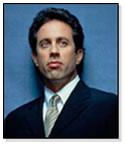
Scene: IT Steering Committee at a mid-size bank smack dab in the center of Gonzo land set to kick off at 1PM on a sleepy Tuesday afternoon. Participants are gradually arriving. Everyone goes to their usual seats.

Steady Eddie (EVP and Chair of committee): Okay, we have a big agenda, so let’s bring the meeting to order. We have a special guest today. Ann from IT will be presenting a proposal for upgrading our voice infrastructure systems. Harry, do you want to get us started? 
Harassed Harry (CIO): Absolutely. As you know we’ve been living with an antiquated phone system around here for years and we have budgeted for new Voice over IP technology for some time. This is a big part of our five year technology strategy. Ann has been leading the effort to prepare the business case. I will let her give the presentation.
 Analytical Ann (Senior Technical Analyst): Thank you everyone…… Ann proceeds to deliver an extremely well prepared (albeit highly technical) presentation with details of a proposal to spend $675k for a new phone system to include call center and switchboard software. Throughout the presentation, Cool Carl (CEO) has been checking his Blackberry non-stop. As Ann’s talk stretches to 45 minutes, people begin to shift restlessly in their seats. Toward the end of the presentation, Decision Maker Dick (COO) finally shows up for the meeting.
Analytical Ann (Senior Technical Analyst): Thank you everyone…… Ann proceeds to deliver an extremely well prepared (albeit highly technical) presentation with details of a proposal to spend $675k for a new phone system to include call center and switchboard software. Throughout the presentation, Cool Carl (CEO) has been checking his Blackberry non-stop. As Ann’s talk stretches to 45 minutes, people begin to shift restlessly in their seats. Toward the end of the presentation, Decision Maker Dick (COO) finally shows up for the meeting.
 Harassed Harry: Thank you Ann. Good job! As you all can see, we are ready to pull the trigger on this and we would like to get your approval so we can get started on a third quarter implementation.
Harassed Harry: Thank you Ann. Good job! As you all can see, we are ready to pull the trigger on this and we would like to get your approval so we can get started on a third quarter implementation.
 Steady Eddie: Very good job, Ann. Thanks for the presentation. I know you’ve got a lot to do today. We’ll let you get back to your very important work and we’ll discuss this a bit and let you know of our decision. Conversation halts while Ann scurries out of the room. Okay, does anyone want to start the discussion?
Steady Eddie: Very good job, Ann. Thanks for the presentation. I know you’ve got a lot to do today. We’ll let you get back to your very important work and we’ll discuss this a bit and let you know of our decision. Conversation halts while Ann scurries out of the room. Okay, does anyone want to start the discussion?

Retail Rita (Head of Retail): I’m worried about our customer presence. I don’t like the idea of a computer answering the phone instead of a person. Our customers won’t like it. We have a “high touch” organization.

Tight Tim (CFO): Is this really the time to be making such a large investment? Hasn’t anyone read the papers? I would think we would want to delay this and conserve our cash unless it’s really necessary.
 Harassed Harry: You should know that most banks our size went to new voice technology years ago, and we don’t currently have a fallback plan if our aging equipment fails. As a matter of fact, support was withdrawn from it two years ago.
Harassed Harry: You should know that most banks our size went to new voice technology years ago, and we don’t currently have a fallback plan if our aging equipment fails. As a matter of fact, support was withdrawn from it two years ago.
 Cool Carl: Mention of no fallback plan for the phone system catches Carl’s attention. What! We don’t have any disaster recovery for our voice systems? Why hasn’t anybody told me this before?! Harry, you and I need to talk after this meeting is over. We need to close this gap immediately! Having said that, I defer to Tim on whether we have the money to spend. This is a sticky situation. Immediately returns to his Blackberry and falls into contemplation.
Cool Carl: Mention of no fallback plan for the phone system catches Carl’s attention. What! We don’t have any disaster recovery for our voice systems? Why hasn’t anybody told me this before?! Harry, you and I need to talk after this meeting is over. We need to close this gap immediately! Having said that, I defer to Tim on whether we have the money to spend. This is a sticky situation. Immediately returns to his Blackberry and falls into contemplation.
 Harassed Harry: To address the cost savings, we are likely to be able to reduce the switchboard operators if we can use the new system to answer the phone and route the calls. The new system has skills based routing where we can create areas of specialization in our call center and actually improve our relationship with our customers!
Harassed Harry: To address the cost savings, we are likely to be able to reduce the switchboard operators if we can use the new system to answer the phone and route the calls. The new system has skills based routing where we can create areas of specialization in our call center and actually improve our relationship with our customers!
 Decision Maker Dick: I’m not really comfortable with IT weighing in on whether this is going to benefit our customer relationships. I think we ought to put that on the back burner for a minute. It looks to me as though we are trying to justify a new technology through intangible benefits that may or may not be there. I recommend we shift our focus to where the problem is, i.e., the old stuff is obsolete. I say we authorize Harry to go out and scavenge old equipment and stockpile some spares. We can address this issue better when the economic climate changes.
Decision Maker Dick: I’m not really comfortable with IT weighing in on whether this is going to benefit our customer relationships. I think we ought to put that on the back burner for a minute. It looks to me as though we are trying to justify a new technology through intangible benefits that may or may not be there. I recommend we shift our focus to where the problem is, i.e., the old stuff is obsolete. I say we authorize Harry to go out and scavenge old equipment and stockpile some spares. We can address this issue better when the economic climate changes.

Tight Tim: I’m much more comfortable with that.
 Harassed Harry: But this thing may pay for itself with reduced phone line charges. Shouldn’t we be looking for new technology that pays for itself? Everybody’s doing this!
Harassed Harry: But this thing may pay for itself with reduced phone line charges. Shouldn’t we be looking for new technology that pays for itself? Everybody’s doing this!
 Retail Rita: You need to understand that we are not everybody! That’s how we maintain a difference between ourselves and our competition. We have to be better, smarter, you know……Different!
Retail Rita: You need to understand that we are not everybody! That’s how we maintain a difference between ourselves and our competition. We have to be better, smarter, you know……Different!
Harry now shuts down. His well prepared presentation for a state of the art voice system has somehow been derailed into an effort to provide backup capabilities for the current obsolete PBX (that isn’t even owned by IT). His cognitive processes can’t reconcile the disconnect between everyone’s desire to be better than the competition with a failure to invest in the latest technology. He’s left wondering how he is going to explain this to Analytic Ann who has spent the last six months getting the proposal ready. He’s particularly frustrated with his peers, who were privately supportive but in public failed to back him up. He’s left thinking, why in the world would he want to be CIO of an organization that thinks it’s a competitive advantage to fall behind peers in technology?
 Harassed Harry: Obviously this plan isn’t ready to go yet. How about we take another run at it and bring it back for next month’s meeting?
Harassed Harry: Obviously this plan isn’t ready to go yet. How about we take another run at it and bring it back for next month’s meeting?
 Steady Eddie: Harry, that’s an excellent idea. Thank you for being willing to take another shot at this. Meanwhile, I assume we don’t need a vote today. Let’s proceed with the agenda……
Steady Eddie: Harry, that’s an excellent idea. Thank you for being willing to take another shot at this. Meanwhile, I assume we don’t need a vote today. Let’s proceed with the agenda……
… … …
I feel sure that many of our GonzoBankers out there have been in meetings like this where a very important proposal was presented and it didn’t get approved for funding. The resulting confusion can be a downer for the presenter and the decision makers as well. But all in all, the approval process and associated scrutiny are a vital and healthy part of IT governance.
As we are all aware, we are smack in the middle of a very challenging economic climate where we can expect approval of significant investments to be even more closely scrutinized. Citigroup recently released the results of a survey of IT CIOs in the United States where there were expectations of the first decline of IT budgets in five years. In the survey, overall declines were estimated to be 2.7% this year. Gartner predicted that the decline of IT spending will exceed that of 2001 and be close to 3.8% with the steepest declines being in hardware (close to 15%).
So what’s the deal? Should we all be good stewards of the bank’s money and just quit proposing upgrades and enhancements until a healthy economy sometime in our future solves our problems? Heck no!! This is a buyer’s market where real needs can be pursued with a long term benefit to your bank. If you have an effective, long term technology strategy and can lay out proposals for investments that support that strategy and show an acceptable return on investment, then that proposal will eventually get approved. In the example above, this proposal failed not because of the economy, but because of the two P’s: Preparation and Presentation.
At Cornerstone, we all sit in on our fair share of executive presentations. We have seen everything from presentations that were dead from the time they got out of the gate, to outrageously expensive proposals that were “rubber stamped” even though all of the due diligence wasn’t done. Today, we want to present our thoughts on what constitutes an effective proposal based on a typical scenario as described above.
What can the CIO do to increase the odds for success?
What can IT steering committee participants do to help ensure the most productive meeting?
It would be safe to say that Harry needs to go back to IT and console Ann. He has to regretfully inform her that he promised on her behalf to modify the proposal and present it again at next month’s IT steering committee.
That would be on another sleepy Tuesday.
-br
It’s time for a plan… a plan of action that will integrate technology initiatives with process improvement and product/channel development opportunities.
Cornerstone Advisors can help you analyze your bank’s technology infrastructure, applications, outsourcing relationships and support staff. We can help you put in place an IT Governance Steering Committee to manage the technology decision making process.
These are only a few of the benefits of a Cornerstone Strategic Technology Assessment. It’s the ideal first step in your Strategic Technology Planning process.
Visit Cornerstone’s Web site or contact us to learn more.